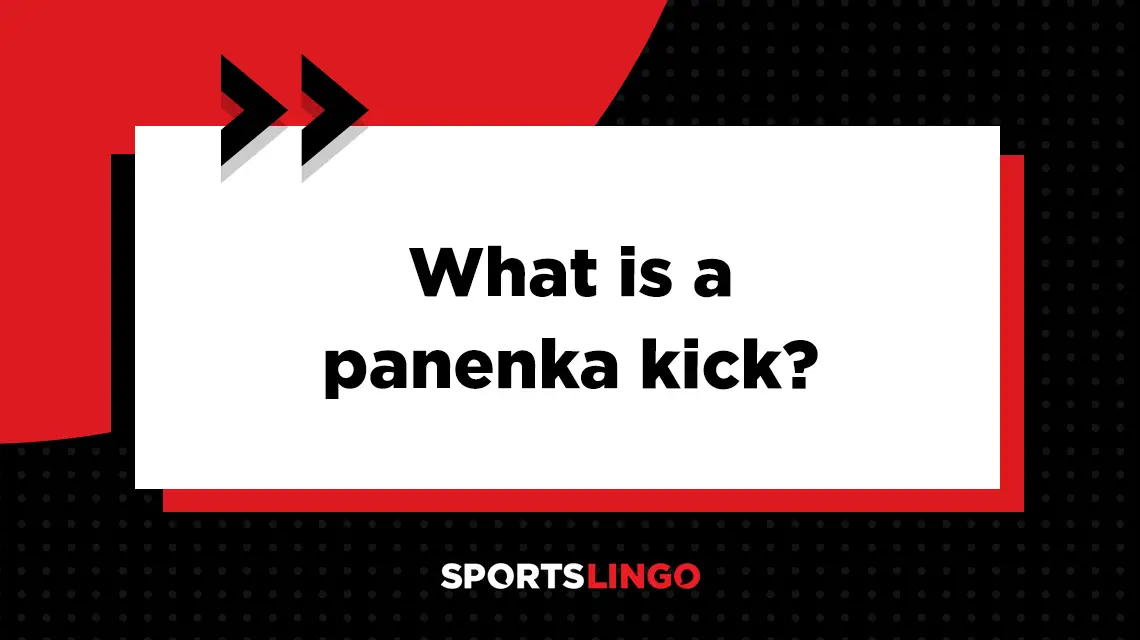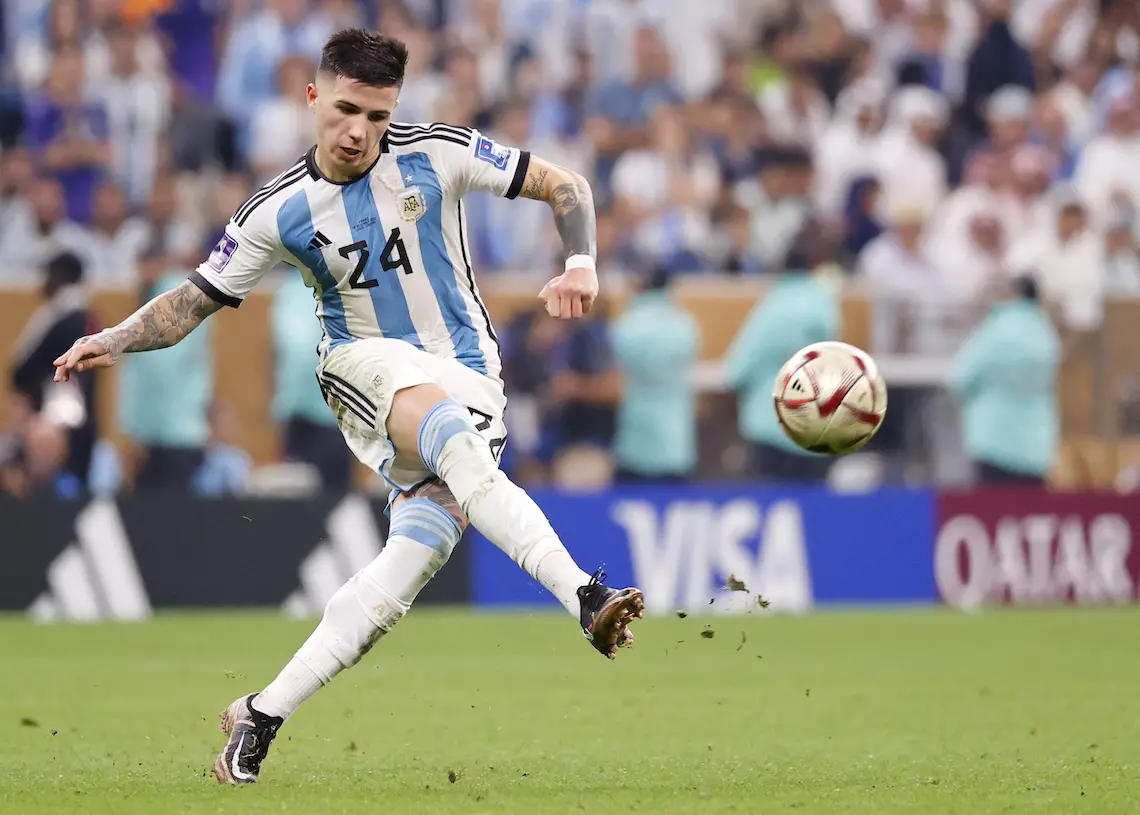
pa*nen*ka
What is the definition of panenka in soccer?
1. The panenka is a strategic type of kick used during penalty kicks. Instead of the player kicking the ball hard to either corner of the goal, the player gets underneath the ball and lifts it softly towards the middle of the goal.
By using the panenka, the player hopes to catch the goalkeeper off guard. With the keeper diving to either side of the goal, the kicker has an easy goal in the center.
Why is a panenka called a panenka?
The panenka technique is named after Antonín Panenka, a Czech soccer player. Panenka is the one who pioneered the kick, and he first used it in the UEFA 1976 European Championship Final. Panenka debuted the kick in the penalty shootout, with the underdog Czechoslovakia team facing off against reigning World Cup champions West Germany.
Panenka was last in the penalty shootout lineup for Czechoslovakia. West Germany’s Uli Hoeneß had just missed his shot, so the score for the shootout sat at 4-3. The Czechs were poised to win the championship on the next kick. It was all on Panenka’s shoulders as he stepped up to take his penalty shot against West German goalkeeper Sepp Maier.
After the referee’s whistle, Panenka began moving toward the ball at a quick pace as though he planned to kick it swiftly at the corner of the net. But just before striking the ball, he slowed down and gently chipped it up and over Maier, who dove to the side. The ball floated straight down the middle, landing in the centre of the goal and earning Czechoslovakia a shootout victory. A video of Panenka’s winning penalty shot can be seen here.
Other names for the panenka kick
In Czech language, the kick was originally known as Vršovický dloubák. This name comes from the Prague district of Vršovice, the home of the Bohemians Praha 1905 football club where Panenka played for most of his career.
Other parts of the world have unique names for the panenka penalty kick, such as:
- Italy: Il cucchiaio, meaning “the spoon”
- Brazil: Cavadinha, meaning “little dig”
- Argentina: Penal picado, meaning “poked penalty kick”
What is the meaning of panenka in football?
In association football, a panenka refers to the technique of chipping the ball into the center of the goal on a penalty kick. This is a strategic way of taking a penalty kick (also known as a spot kick) in soccer.
What does panenka mean?
Some people think that panenka may be a foreign term. However, there is no English translation for panenka because it comes from a player’s name.
Antonín Panenka is the Czech soccer star who invented the panenka. Although he didn’t dub the kick with his own name, it became widely known as the panenka after he used it effectively in the final game of the UEFA 1976 European Championship.
What is a panenka free kick?
A panenka can be used on any type of penalty kick. That includes penalty shots which are taken in place of a direct free kick as the result of a foul in the penalty area.
What is a panenka penalty?
A panenka penalty is a way to describe using a panenka shot on a penalty kick. It may be used when taking a penalty shot awarded during the game or in the course of a penalty shootout.
How is a panenka different from a regular penalty kick?
The difference between a panenka and a regular penalty kick is that a panenka is a particular technique used for penalty shots. A regular penalty kick can be taken in any manner by the kicker as long as they follow the rules of the game. A panenka involves a specific strategy for making a penalty shot by faking out the keeper and chipping the ball toward the center of the goal.
How is a panenka different from a regular free kick?
The difference between a regular free kick and a Panenka free kick is that a Panenka is only taken from the penalty mark in the box. Regular free kicks may be taken from anywhere on the field. The only time free kicks are taken from the penalty mark is when a team in its own penalty area commits a foul that would normally result in a direct free kick.
What is the difference between a panenka and a roulette?
The difference between a panenka and a roulette is that a panenka is a technique for penalty shots, and a roulette is a technique for dribbling.
A roulette is a dribbling move that involves a player doing a 360-degree spin to maneuver past a defender. While spinning, they maintain control of the ball by placing their foot on top of it during the first half of the spin, then dragging it back with their opposite foot during the second half.
Other names for the roulette include the Marseille turn, the 360 and the double drag-back.

Yukihito Taguchi/USA TODAY Sports
What are the benefits of Panenka kicks?
The Panenka kick is especially effective at faking out the keeper. When properly executed, the keeper will dive to one side, which clears the center of the goal for an open shot.
With the goalkeeper out of the way, the player doesn’t have to shoot the ball at a high velocity to get it past them. Instead, they can maintain a bit more control over the ball with a slower, precise chip into the middle.
What is the goal of the panenka?
The purpose of the panenka kick is to misdirect the goalkeeper and create a better scoring opportunity on a penalty kick.
Most keepers dive to one side of the goal during a penalty kick. They have to make a snap judgement in the moment to decide which side of the goal to cover. Often, this decision has to be made as the player approaches the ball. If they wait until the ball is already kicked, it may be too late to reach the side of the goal where the ball is headed.
A panenka kick comes as a surprise to most keepers since players rarely choose to shoot right at the center of the goal. Most players choose to aim for a far corner, hoping that it will be out of the keeper’s reach.
Players planning to do a panenka kick often run at the ball as though they’re going for a corner, then slow their pace for a gentle chip to the center at the last minute. This is done to trick the goalkeeper into diving toward one side, which opens up the center of the goal for an easy shot.
Why do they do penalty kicks?
Penalty kicks occur in soccer games for two reasons: fouls and shootouts.
Fouls
If a team in its own penalty area commits a foul that would normally result in a direct free kick, the opposing team is awarded a penalty kick instead. The kick taker is permitted to take a single shot on goal. The opposing team’s goalkeeper is the only other player allowed in the penalty area.
Once the ball is kicked, it is in play and other players on the field may enter the 18-yard box. The kicker can’t touch the ball a second time until it’s touched by another player.
Shootouts
A penalty shootout is used as a tie-breaker in soccer games that cannot end in a draw, including quarterfinals, semifinals and other playoff matches. If the score is still tied at the end of regulation time and extra time, each team will get five shots from the penalty mark.
The teams alternate shots, and the first to get an insurmountable lead wins. If the score is still tied after each team completes five shots, the penalty shootout goes into sudden death rounds to determine a winner.
Panenka kicks in soccer history
Since Antonín Panenka’s iconic penalty kick in 1976, there have been a number of other successful uses of the panenka in important games, including:
- France’s Zinedine Zidane in the 2006 FIFA World Cup Final against Italy
- Chile’s Alexis Sánchez in the 2015 Copa América Final against Argentina
- Italy’s Francesco Totti in the Euro 2000 semi-final against the Netherlands
- Uruguay’s Sebastián Abreu in the 2010 FIFA World Cup quarter-final against Ghana
- Italy’s Andrea Pirlo in the Euro 2012 quarter-final against England
- Paris Saint-Germain’s Lionel Messi in a 2021 UEFA Champions League game against RB Leipzig
- Celtic’s Odsonne Édouard in the 2020 Scottish Cup Final against Heart of Midlothian
- Real Madrid’s Karim Benzema in a 2022 UEFA Champions League semi-final against Manchester City
- Barcelona’s Lionel Messi during a La Liga match against UD Almeria
- Morocco’s Achraf Hakimi in the FIFA World Cup in Qatar against Spain (His panenka shot against Spanish goalkeeper Unai Simon pushed Morocco into the World Cup quarterfinals for the first time in its history.)
Example of how panenka is used in commentary
1. Ramos bursts towards the ball, but deceives Portugal’s keeper and knocks a soft panenka right into the middle of the goal, pushing Spain one step closer to victory.
2. Midfielder Andrea Pirlo stuns Premier League fans with an impressive panenka that floats past Joe Hart in England’s goal.
Sport the term is used
1. Soccer